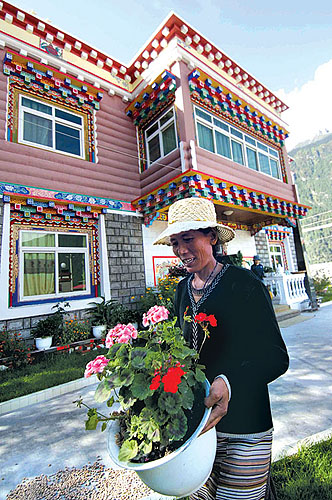|
Tibet is an area where agriculture and animal husbandry are the dominant industries. Among the population of 2.81 million, more than 2.3 million are farmers and herders, accounting for 80 percent of the total. Tibet's GDP increased by over 12 percent each year in the first five years of the 21st century, and the per capita income of farmers and herders has maintained double-digit growth for three straight years. According to statistics, in 2007, per capita GDP reached 12,109 Yuan, up 12.6 percent. Of the total, per capita disposable income of urban resident amounted to 11,131 Yuan, with a year-on-year increase of 24.5 percent, and per capita net income of farmers and herders totaled 2,788, an increase of 14.5 percent. The Engel coefficient of urban and rural households was 50.9 percent and 57.1 percent, respectively.
Housing Project
 Many Tibetan farmers and herders have moved into new houses built for them.
Many Tibetan farmers and herders have moved into new houses built for them.
In recent years, the government of Tibet Autonomous Region, with the people's normal and happy lives as a breakthrough point for building new socialist countryside, carried out the housing project for farmers and herders mainly covering farmers' homes reconstruction, nomadic peoples' resettlement in aid of the poor. The project, once finished, will mean housing will have been provided for 80 percent of the region's farmers and herders by the end of 2010. According to Chen Jin, head of the Tibet construction department, from 2006 to 2007, the regional government invested 6.6 billion Yuan in the housing project, which benefited 570,000 farmers and herders from 112,000 households, and at the same time invested 141 million Yuan in finishing construction of the comprehensive supporting projects for infrastructure for 600 administrative villages. In 2008, the government will earmark 676 million Yuan to help 52,000 farming and herding households move into brick houses or settle down from their former nomadic existence.
The housing project for farmers and herders is carried out through "governmental support, other provinces' aid, bank loan and public self-financing". Every farmer and herder family or poverty-stricken household can draw assistance ranging from 10,000 to 25,000 Yuan, reducing the house-building costs of farmers and herders to the maximum extent. In rebuilding, the choice and living customs of the farmers and herders are fully respected.
|
